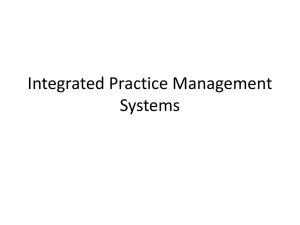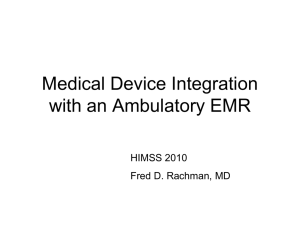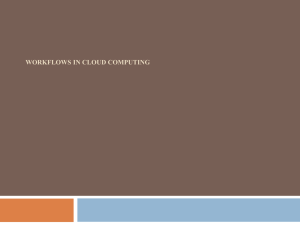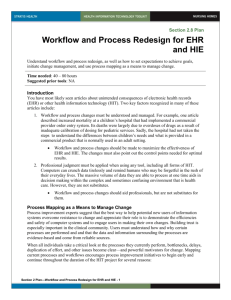Business Process and Data Analytics
advertisement
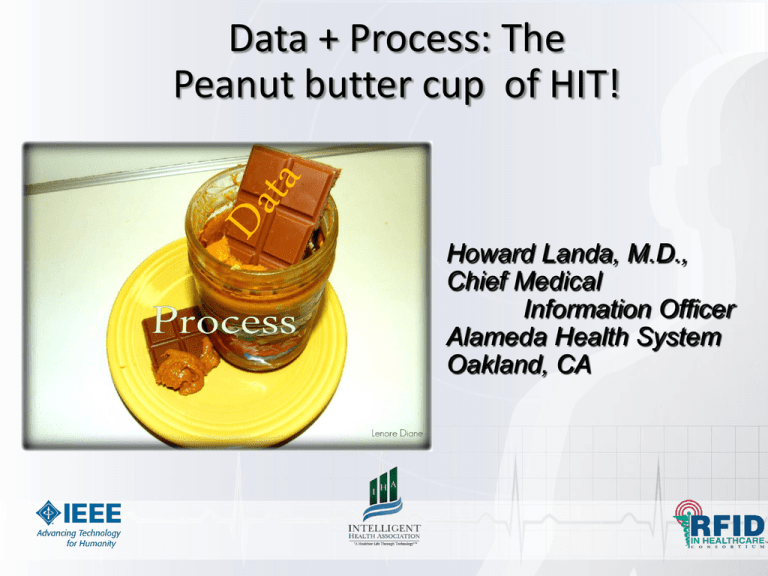
Data + Process: The Peanut butter cup of HIT! Howard Landa, M.D., Chief Medical Information Officer Alameda Health System Oakland, CA Quoting smart people makes you seem smarter • Data is like salt water. It can drown you in its native state, but filtered and processed it sustains life. “The goal is not to drown in data while thirsting for information”-Reid Coleman • Using data to impact processes drives value from the data • Dashboards are not very useful when standing still 2 By any other name… Beyond Meaningful Use MU2 : Meaningful use of Meaningful Use Why we all started doing this: To use technology to improve the process of Healthcare 3 Healthcare Information Technology Truisms 1) The EHR shines a bright spotlight on all your bad procedures, processes and actors 2) Workflow is everything (Implementation) 3) Computers make smart people do stupid stuff 4) Where Workflow isn’t everything, Data is everything 5) Data impacting Workflow is really everything (Optimization) 4 Scenario #1 • Situation – Well resourced Accountable Care Organization – Mature EHR implemented and optimized – Reliable data and clinical decisions support • Goal: – Improve a specific aspect of care – One that Passes the “Champagne test” 5 Goal: Improving Mammogram Screening • Improve ordering of Mammography – Identify Alerting – Ease ordering • Improve cycle time • Improve patient satisfaction with process • Earlier detection Improved outcome Initial attempt • Provide the structure – Alerts and Reminders (Staff and Patients) – Process support • Mature ubiquitous EHR • Incentives – Analytic data • Screening rates, Treatment benefit • Monitor alerts and orders 7 Modest improvement • Modest increased screening rates • PCP most impacted • Data on resistance of other providers – Educational issue? – Ineffective notification? – Ease of ordering issue? – Result workflow? NO NO NO BINGO! 8 Mitigating Reluctance of non-PCP Result-o-phobia The irrational fear of looking stupid when an otherwise competent professional does not know how to deal with a test result. e.g.: • Pediatric urologist sees patient for a circumcision, sees alert and orders a mammogram for his patient’s mother • Result comes back “BIRADS 3, Borderline abnormal” • Pediatric urologist develops sweating and palpations when he realized he has to contact what has inadvertently become “his patient!” Mitigating Reluctance of non-PCP The cure for Result-o-phobia • Ordering provider legally must get the test result Ordering provider gets “Courtesy” copy • APN intercepts ALL results and is accountable for negative study communication and follow-up • Communicates with Breast team non-negative • Breast team accountable for all subsequent care • Resistance is futile! Now we’re talking • Resistance is now mitigated • Kaiser Permanente Hawaii in NCQA 2009 – Highest breast CA screening rate (42 – 69) ~72% 85% in 2009 – EHR can alert and facilitate – Incentives and accountability – Operations to support workflow based on sequential evaluation of analytic data Scenario #2 • Situation – – – – County Hospital/Inner city trauma center Poorly resourced, Resident run Minimal Electronic systems (ED EMR) “The best thing about standards is that there are so many to choose from!” • Goal: To improve the quality of care – Optimize and Standardize disparate paper order sets, leverage evidence and facilitate workflow • Recommendation: CPOE!...when we have $$$ 12 Is there a stepping stone to CPOE? • Electronic Order EntryPaper Output – Increase the number of order sets – Minimize workflow change – Resource “light” implementation – Expedite creation and maintenance of order set content – “Test drive” order sets to support future enterprise EHR 13 Stepping stones to CPOE • Electronic Order Entry with Paper Output – “Electronify” starter/current paper forms – Add “low impact” Clinical Decision support – Expedite creation and maintenance of order set content – Expand functional and conditional order sets – “Test drive” order sets – Iterate! Immediate Clinical Content Committee: Rapid cycle content management Deploy new Content ICCC: Pharmacy HIM User feedback ICCC Design Quality Safety Informatics Order use analytics Care quality improvement • Improved compliance with ordering of complete insulin coverage • DVT prophylaxis compliance has increased from 50% to 97% • Compliance with required orders – E.g. Admit, Code status, Telemetry criteria, Resident/Attending/Service identification • 28% reduction in time from decision to admit to creation of inpatient orders 16 Why it worked • Workflow tools at the Point-of-Care • Clinical Decision Support – Leading and guiding vs. Interrupting • Minimal change to manage • Ordering analytics to support rapid, iterative improvement cycles • Make the “Right” thing to do the “Easy” thing to do 17 Taking it to the next level • Goal: Reduce Sepsis Deaths by 15% • Challenge to get baseline data – Bad data Denial, Anger, Bargaining 3/5 Kubler-Ross • Challenge to impact process with bad data • Change Management a major problem • Need for standardized protocol and procedure for physicians and nurses Overcoming Barriers • Multidisciplinary education • Standardized Protocol and Procedures – Physicians and nurses – Sepsis education • Paper based pilot Sepsis the Highland Way Youtube video Initial results promising but limited • Data evaluation and process iteration – Lactate not coming back quickly POCT testing – Antibiotic Delivery: Involve Pharmacy Change Management: Making resistance futile – Paper to Electronic • ED order sets in EMR • Admission in SmartOrders • Provider and nurse focus and education Way better! • From 2009 to 2011 56% reduction in sepsis mortality! But… – Bundle compliance still not close to 100% – Significant paper processes remained – Data collection was still a challenge – Change is hard, maintaining change is harder Let’s implement an EHR! • Mid-2012 through Early-2013 we implemented ambulatory and inpatient EHR • Better order processing • Better decision support • Lots of distraction (Quality, Clinicians, IT) • Rule #2: Workflow is everything (during Implementation) Let’s optimize and EHR! • Don’t drown in data while thirsting for info – Too much data, not enough information – Too much distraction and too much change – Meaningful Use <> Using Meaningfully Rule #5: Data impacting Workflow is really everything (Optimization) Identify and track key metrics Implement process improvements and iterate! Still in early phase 24 Success factors • It is NOT just the data or just the workflow! • Use good data to drive great change • Manage the change: – Make the change feel do-able: small bites – Try to pass the Champagne test – Make the “Right” thing to do the “Easy” thing to do • Metrics are tools, not destinations. The process of Healthcare is just that, a process. 26





